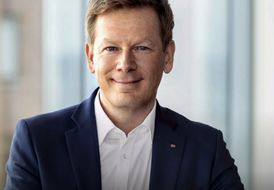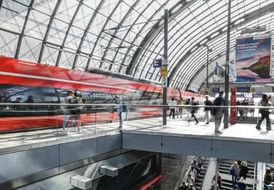Markets and strategy
We are facing a period of significant change. The mobility market will keep growing and changing. Digital solutions are significantly accelerating this development. New forms of mobility are emerging and car transport is being questioned. Social structures are also changing: the age gap is continuing to expand; cities are growing and stretching their infrastructures to their limits; rural areas are shrinking but must nevertheless maintain their access to mobility.
We have therefore further developed key parts of the strategy of DB Netze Stations. The basis for implementing the strategy is restructuring the organization. All structures and processes are aimed at the needs of passengers and visitors and feed into the Strong Rail strategy.
- More robust: With uniform production standards, we are continuously improving the perceptible quality at our stations and in the surrounding area. Through standardization and increasing digitalization, processes are streamlined, maintenance measures are optimized and we are switching to additional status-oriented and demand-oriented production concepts. We are investing in new construction projects and developing future-oriented capacity concepts to ensure our infrastructure is robust, attractive and secure in order to help achieve the desired shift in the mode of transport and support the increase in passenger numbers.
- More efficient: As part of the lean excellence transformation, we will establish a lean-thinking and lean-acting organization that is characterized by further developed cultural aspects and a pronounced lean mentality among all employees. This lays the foundations for excellent performance and continuous improvement of processes. Our processes begin with customers and their requirements, and we develop effective solutions to increase customer satisfaction. With the new setup of our performance processes, we ensure that our actions are aligned with the needs of our customers and systematically collect their feedback. Through consistent end-to-end management, we increase our ability to control processes and our overall effectiveness. With the established systematic derivation of targets, we focus and align business units on the key elements for strategy implementation. The introduction of comprehensive performance management for all organizational units creates transparency about relevant key figures and enables clear control along our customer-oriented processes. This also includes the ongoing standardization and digitalization of core processes to increase efficiency.
- More modern: We wish to improve the quality of our guests’ stays at our stations. We intend to integrate stations even more comprehensively and effectively into people’s everyday lives and make their stays attractive by providing relevant offers. Comfortable waiting areas, a welcoming forecourt, redesigned concourse buildings and improved service help make passengers and visitors feel more at home at the station. We are optimizing our passenger information system and further developing our guidance systems so that passengers and guests from the neighborhood can find their way around as quickly as possible. We are continuing to expanding WiFi availability at stations. Through the Smart City Initiative, we are making stations and their surroundings more attractive. We are developing innovative usage concepts for stations, rethinking station neighborhoods and ensuring interlinked, sustainable mobility. This includes new everyday services such as smart lockers, options for remote working at stations, attractive forecourt designs including sharing spaces for onward travel, and micro hubs for city logistics.
- Greener: In order to improve our ecological footprint, we aim to reduce CO₂ emissions, make our use of materials greener in line with the principles of the circular economy and expand biodiversity at our stations. As a result, we are continuously increasing our energy efficiency through energy-saving renovations and replacing lights with LEDs. We are continuing to push for the use of eco-power at our stations. By 2025, we will achieve a reduction in CO₂e emissions by 81% or respectively 137,000 t compared with 2019 (Scopes 1 and 2) through the use of 100% eco-power and increased energy efficiency. We are also focusing on new concepts for onward travel mobility services, ranging from digital services such as the DB Rad app to bicycle repair service Radfix. In addition, we are testing a sustainable construction approach for small stations with the little station project. Through the BALIN research project, we are also researching the possible effects of station lighting on insects.


